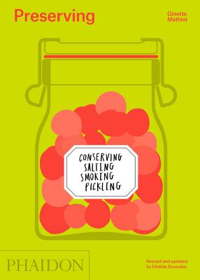
Who needs to know about conserving, salting, smoking and pickling?
Everyone.
Whether you have a vegetable garden, visit a farmer’s market, orchard, or even a supermarket with a good sale on pork or peaches, you need to know what to do with extras. Get a copy of Ginette Mathiot’s classic Preserving: Conserving, Salting, Smoking, Pickling (Phaidon 2015) revised and update by Clotilde Dusoulier.
 This is a wonderful, comprehensive, insightful guide on what to do with extras. It was published in the years after WWII when the French government rationed food. But it is inspiring now when we still want to eat well and adventurously. Clotilde writes in the introduction:
This is a wonderful, comprehensive, insightful guide on what to do with extras. It was published in the years after WWII when the French government rationed food. But it is inspiring now when we still want to eat well and adventurously. Clotilde writes in the introduction:
So whether you’re a city dweller wanting to gift ruby jars of strawberry jam to lucky friends, or a country mouse needing to manage your harvest carefully, you can call upon Ginette Mathiot’s no-nonsense voice and straightforward advice to guide you on your preserving journey. (p. 10)
It is truly satisfying to prepare foods from scratch and be able to enjoy the bounty of the garden in the depths of winter or next week when you still long for a bit more.
The book is organized around ingredients from Aromatic Herbs to Milk, Fish, Poultry, and more, and then sections on charcuterie, and curing and smoking. The first section contains general information on storing food. There is a handy Kitchen Garden Calendar (pp. 18-20) and another illustration for an apple silo under straw. She includes a list of preserving techniques and instructions for dry curing, brining, jam making and more. The chapter on poultry includes a recipe for making Duck Confit (p. 89) and Stuffed Goose Neck (p. 93), one of the best uses of goose, pork sausage, and goose fat ever created. Craving rillettes to pack off for a lunchtime treat? Make them yourself. Rabbit Rillettes (p. 100) with a layer of pork fat will last all winter or until you eat them. There are more three variations of pork rillettes, pate, sausages, and boudin recipes in the charcuterie section, including a useful recipes for Pigs Feet (p. 297) prepared with white wine or cider, cloves, and pepper.
The sections on vegetables and fruits are equally useful. Not all the recipes are sweet. The first is for unusual Apricots in Vinegar (p. 154) made with green, unripe apricots that are pickled and served “like gherkins.” If you go to a pick-your-own apple orchard this fall, you could make Normandy Style Apple Jam (p. 217) with raisins, currants, orange peel, and a good amount of Calvados, or a Brittany style Apple Jam (p. 218) with dry cider. She also will teach you how to prepare various types of dried apple slices the French like to serve instead of chips all year round. This winter, buy some extra chestnuts and make the French delicacy Marrons Glacés (p. 189) for an exquisite New Years gift.
Preserving is an exquisite book that is both modern and dated. It’s a glimpse of how French women half a century ago used their skills to preserve the bounty around them – something many still do in France – and a call for all of us to do the same. Give this book to a good friend with a case of empty mason jars and you will be rewarded!
